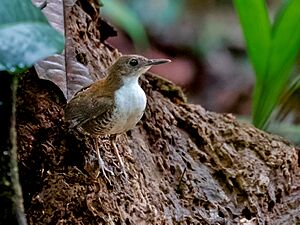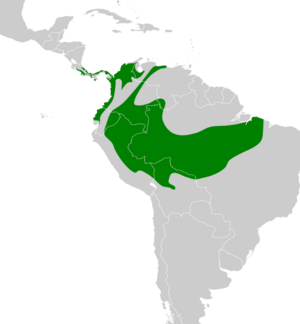Southern nightingale-wren facts for kids
Quick facts for kids Southern nightingale-wren |
|
|---|---|
 |
|
| From Careiro, Amazonas, Brazil | |
| Conservation status | |
| Scientific classification | |
 |
The southern nightingale-wren (Microcerculus marginatus) is a small bird also known as the scaly-breasted wren. It belongs to the Troglodytidae family, which includes wrens. You can find this bird in several countries in Central and South America, including Bolivia, Brazil, Colombia, Costa Rica, Ecuador, Panama, Peru, and Venezuela.
Contents
About the Southern Nightingale-Wren
The southern nightingale-wren is closely related to the northern nightingale-wren. In the past, some scientists thought they were the same species. However, today, most bird experts agree they are two separate species. Different groups of scientists might even call them by slightly different English names.
This bird has six different types, called subspecies. Sometimes, one of these subspecies, M. m. luscinia, is even thought to be its own separate species! Another subspecies, M. m. marginatus, is also sometimes considered one or two separate species, depending on whether it lives on one side of the Amazon River or the other.
Here are the six subspecies:
- M. m. luscinia
- M. m. corrasus
- M. m. squamulatus
- M. m. occidentalis
- M. m. taeniatus
- M. m. marginatus
What Does It Look Like?
The southern nightingale-wren is about 11 cm (4.3 in) long. Male birds usually weigh between 18.2 to 22 g (0.64 to 0.78 oz), while females are a bit lighter, weighing 17 to 18 g (0.60 to 0.63 oz).
The most common type of this bird has a dull gray-brown face. Its head and upper body are a deep chocolate-brown color, with a reddish tint near its tail. It has a very short, dark chocolate-colored tail. The bird's chin, chest, and upper belly are white. It has some black, scale-like patterns on the sides of its chest. The lower sides and lower belly are dark chocolate. Young birds look similar but have dark bars on their head and back. They also have dark brown tips on their belly feathers.
Other subspecies have slightly different looks:
- M. m. squamulatus has scale-like markings on its belly.
- M. m. taeniatus also has scaly underparts and more reddish color on its upper body. It also has blackish bars on its belly.
- M. m. corrasus is similar but has a purer white belly with narrow dark bars.
- M. m. occidentalis has a longer, thinner beak. Its upper body and sides are darker, and it has wide dark bars on its belly.
- M. m. luscinia has a pale gray throat that turns brownish-gray on its chest and belly.
Where Do They Live?
Each subspecies of the southern nightingale-wren lives in a specific area:
- M. m. luscinia lives from central Costa Rica to eastern Panama.
- M. m. corrasus is found in the Santa Marta region of northern Colombia.
- M. m. squamulatus lives in northern Colombia (except Santa Marta) and northern Venezuela.
- M. m. occidentalis can be found in western Colombia and northwestern Ecuador.
- M. m. taeniatus lives in western Ecuador.
- M. m. marginatus is spread across the Amazonia region. This includes parts of Venezuela, Ecuador, Colombia, Peru, Bolivia, and Brazil.
These birds prefer to live in the lower parts of thick, wet tropical forests. They have been seen at different elevations: from sea level up to 1,700 m (5,600 ft) in Costa Rica, up to 1,400 m (4,600 ft) in Colombia, and up to 1,800 m (5,900 ft) in Venezuela. There was even one sighting in Panama at a very high 3,100 m (10,200 ft).
How They Live
What They Eat
The southern nightingale-wren usually searches for food alone. It looks for food on the ground and in the low bushes of the forest. We don't know much about what exactly it eats. Sometimes, in Central America, it has been seen following groups of army ants, but it doesn't seem to do this all the time.
Reproduction and Nests
Most of what we know about the southern nightingale-wren's breeding habits comes from Panama. It seems they can breed almost all year round. Scientists have found two nests. These nests were made of leaves and were built at the end of burrows. It's likely that other birds dug these burrows first. One nest had two eggs, and the other had three.
Their Songs
The songs of the southern nightingale-wren sound different depending on where the bird lives. Birds in Central America and western Amazonia sing long, complicated songs with many short notes followed by several whistles. Birds in Peru and Bolivia sing "clear, pure notes" that are given randomly. These notes change in how high or low they are, how long they last, and how loud they are.
Conservation Status
The IUCN (International Union for Conservation of Nature) has decided that the southern nightingale-wren is a species of "Least Concern." This means they are not currently worried about it becoming endangered. The bird "appears to be well distributed" across most of its habitat. It also lives in several protected areas and national parks, which helps keep its populations safe.


